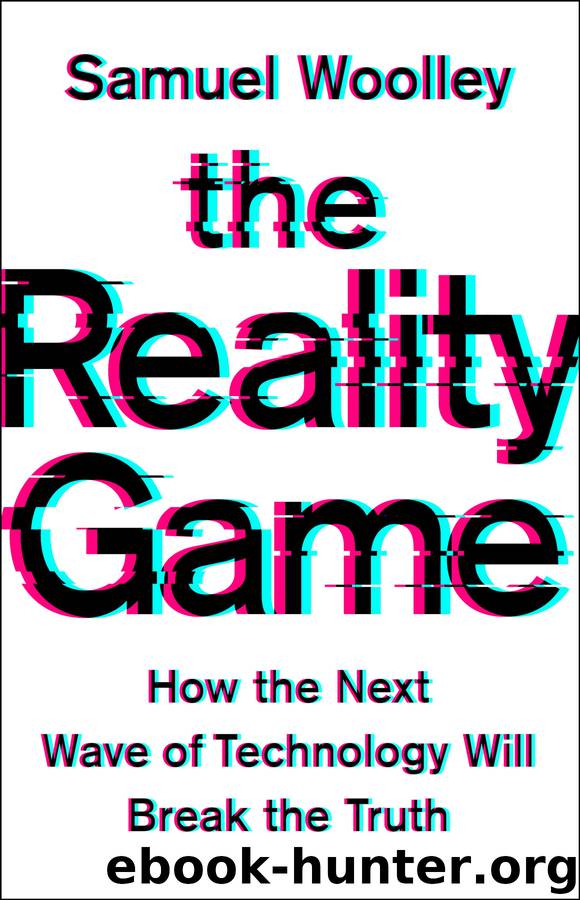The Reality Game by Samuel Woolley

Author:Samuel Woolley
Language: eng
Format: epub
Publisher: PublicAffairs
Published: 2020-01-06T16:00:00+00:00
The YouTube Problem
YouTube largely escapes notice in many of the computational propaganda events I’ve sat in on. Twitter, Facebook, and even Reddit are more readily offered up as examples of platforms where computational propaganda and other forms of technically enhanced manipulation run rampant. But YouTube has its fair share of problems, most notably its history of placing disinformative and conspiracy theory–laden videos at the top of trends on its home pages and quickly linking people to extremist videos after they’ve watched less partisan ones.30 Some of these videos are also amplified by bots that link and spread them across the internet and other social media platforms, giving them further currency among the general public.
Researcher Becca Lewis has demonstrated that YouTube is a favorite medium of white nationalists and the alt-right. In her report “Alternative Influence: Broadcasting the Reactionary Right on YouTube,” Lewis argues that the website’s facilitation of the platforms for numerous extremist “influencers” amounts to what she calls an “alternative influence network.”31 She writes that, “by connecting to and interacting with one another through YouTube videos, influencers with mainstream audiences lend their credibility to openly white nationalist and other extremist content creators.” She also points out that all influencers, including those who peddle far-right conspiracy theories, can and do use YouTube to make money—sometimes in very large amounts.
But the problems with YouTube are not only associated with its use to spread polemic and, at times, disinformative content from both the right and the left. Nor are its problems tied to the fact that people can make money by doing so. There are other issues similarly grounded in the way YouTube functions. These problems exist both in the code and in the human-based guidelines for prioritizing certain content over others.
According to the Google News Initiative, YouTube does in fact organize breaking news and other content based on quality metrics, including perceptions of the authority of the news outlet. It has actually begun to take credit for doing so as part of a multimillion-dollar endeavor aimed at building bridges between YouTube and the news media. In fact, Mashable reports, the media giant has now started showing breaking news at the top of its search mechanism.32 At first glance, the company is working to prioritize content that it deems newsworthy or “authentic” instead of sharing conspiracy theories or disinformation. But underneath this appearance, the company is still quietly curating the news content that people get to see. Perhaps YouTube should let us all in on how it makes these choices?
In some ways YouTube is damned if it does and damned if it doesn’t. If it leaves manipulative or misleading content on its site, it is criticized. If it curates such content, it is similarly attacked. YouTube is clearly taking action, but some elements of transparency are missing from its efforts. There is a lack of clarity about how YouTube works to rank videos. What role do algorithms play in this practice? What is the role of human moderators? What signals are used
Download
This site does not store any files on its server. We only index and link to content provided by other sites. Please contact the content providers to delete copyright contents if any and email us, we'll remove relevant links or contents immediately.
The Secret History by Donna Tartt(18860)
The Social Justice Warrior Handbook by Lisa De Pasquale(12143)
Thirteen Reasons Why by Jay Asher(8800)
This Is How You Lose Her by Junot Diaz(6802)
Weapons of Math Destruction by Cathy O'Neil(6152)
Zero to One by Peter Thiel(5692)
Beartown by Fredrik Backman(5609)
The Myth of the Strong Leader by Archie Brown(5429)
The Fire Next Time by James Baldwin(5252)
How Democracies Die by Steven Levitsky & Daniel Ziblatt(5133)
Promise Me, Dad by Joe Biden(5089)
Stone's Rules by Roger Stone(5028)
A Higher Loyalty: Truth, Lies, and Leadership by James Comey(4851)
100 Deadly Skills by Clint Emerson(4845)
Rise and Kill First by Ronen Bergman(4705)
Secrecy World by Jake Bernstein(4652)
The David Icke Guide to the Global Conspiracy (and how to end it) by David Icke(4629)
The Farm by Tom Rob Smith(4442)
The Doomsday Machine by Daniel Ellsberg(4420)
